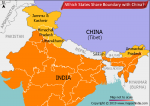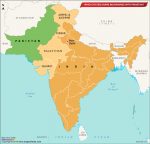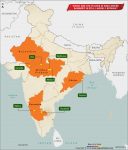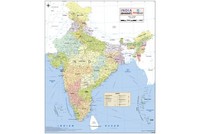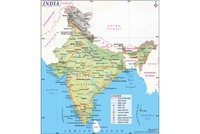One of the greatest batsmen of the modern era and India’s most adored sportsperson, Sachin Ramesh Tendulkar was born on 24 April 1973 in Mumbai. His father, Ramesh Tendulkar, was a college professor, and his mother, Rajni, was employed in an insurance firm.
Sachin Tendulkar was introduced to cricket by his older brother, Ajit, who was also responsible for the renowned cricket coach Ramakant Achrekar accepting the young Tendulkar as a pupil. Impressed by the boy’s talent, Achrekar would push him to do better by putting a one-rupee coin on the stump top, and if Tendulkar lasted an entire session without getting out, the coin was his.
Many years later in an interview Achrekar said: “The first time I saw Sachin, he seemed to be just like the other boys, nothing special. But then I watched him in the nets, and he was middling the ball all the time, hitting it hard, never playing defence. He had good wrist work, and wonderful reflexes. . . . Sachin loved to play. He never wanted to miss a match.”
At school and club level, Tendulkar was barely in his teens when there was a buzz around him. When he was 14, he went to Chennai’s MRF Pace Foundation but there the great Australian pacer Dennis Lillee suggested it might be a better idea if he concentrated on batting instead.
It was sound advice.
Not long after, Tendulkar and his future India teammate Vinod Kambli—another student of Achrekar—catapulted to national attention when they put together an unbelievable 664-run partnership in an inter-school tournament. Rahul Bhatia would later write on ESPNCricinfo: “Among many fine strokes that were played in their innings, one stood out: a drive from Tendulkar that sped past the bowler, gathered pace as it hurtled by the fielder, and went so far that Shardashram (Sachin’s school team) earnestly wondered if they should lend the fielder a scooter to fetch the ball.” In the bowling side, one boy was in tears.
Tendulkar, who had not yet turned 16, made his first-class cricket debut for Mumbai in December 1988, scoring a century against Gujarat. In the months to follow, the runs quickly piled up and old-timers in Mumbai’s cricketing circles started scratching their heads to remember if they had seen a batting talent quite like this at such a young age.
A young genius
It was a question of when—not if—the call for the national squad would come. Tendulkar didn’t have to wait long. Aged 16, he made his Test debut in Karachi against a formidable Pakistani pace attack. Though he scored only 15 runs in the match, he was noticed for not being rattled after being repeatedly hit on the body.
The disdain with which he could treat bowlers was, however, soon on display in an exhibition match in which the baby-faced, curly-haired Indian batsman smashed four sixes and a four in a single over of spinner Abdul Qadir. The great Pakistani bowler Wasim Akram later recollected: “Even though it was not an official one-dayer, it was being played in all seriousness like all India-Pakistan encounters. Moreover, Qadir was bowling at his peak in those days, and was treated with respect by the top batsmen the world over. Everyone who saw that match realised that Tendulkar would dominate the best bowlers in the world in time to come, and that he loved the challenge of playing and destroying quality bowling.”
Tendulkar hit his first Test ton at Old Trafford in Manchester in 1990. His first One Day International hundred—on 9 September 1994 against Australia in Colombo—took more time. But then the hundreds kept coming.
It’s difficult to shortlist Tendulkar’s finest innings, since there are so many remarkable ones. Among his most memorable Test knocks was the 114 against Australia in Perth in 1992. As Ben Bloom wrote in The Telegraph: “Arguably Tendulkar's finest ever innings, the Little Master gained the respect of everyone in Australia with this dogged innings. On one of the quickest wickets in the world Tendulkar refused to bow down to Craig McDermott and Merv Hughes as wickets tumbled around him.”
Another one was 241 not out, also against Australia. His teammate Rahul Dravid later said of the innings: “The game meant so much to him (Tendulkar) and he never lost track of the fact that he had to earn every run. His game was built around the basics. He was solid in defence, had all the shots and was an extremely good judge of length and line.”
So many memories
Brilliant in both versions of the game, Tendulkar was the highest-scoring batsman in the 1996 World Cup. One of his extraordinary ODI knocks came in Sharjah against the Aussies in 1998, an innings which was dubbed the ‘Desert Storm’. Though India lost the match, Tendulkar’s 143 ensured that his team entered the finals of the Coca Cola Cup, which they eventually won.
Recalling a Tendulkar over in that innings, Arunabha Sengupta wrote on Cricketcountry.com: “Kasprowicz was the first to be blown away. Tendulkar skipped down the track as if playing an old fashioned lob bowler, and launched an attempted slower ball cross batted over the deep mid-wicket. The next ball was the standard fast bowler’s retaliation. The bouncer was pulled over square-leg for another six. When Kasprowicz strayed slightly on the legs, he was delicately tickled fine for four.”
In his 24-year-long career, Tendulkar scored nearly 16,000 Test runs at an average of 53.79. His One Day record reads 18,426 runs at an average of 44.83. In total, he scored a hundred Test and One Day centuries. But statistics, extraordinary as they are, don’t tell the whole story. Tendulkar was not merely a great cricketer. For many Indians, he was the ideal hero, and when he came out to bat, people huddled around television sets in offices, homes and street shops. His batting gave them moments of unadulterated joy, made more precious by the lurking fear that he would get out.
And when he did, as most batsmen must, the collective hush in the stadium (if the match was being played in India) was matched only by the disbelief on the faces of tens of millions of fans around the country. Some would even switch off their television sets.
And though India often lost despite the presence of Tendulkar, he only rose in the esteem of his countrymen. There were other batsmen in the time of Tendulkar who are legends in their own right—most notably Sourav Ganguly and Rahul Dravid—but there was something about Tendulkar which made him stand above the rest.
Besides his obvious batting wizardry, it’s perhaps how he conducted himself on and off the field which left a lasting impression, the “depth of character”, as leadership coach Paddy Upton put it in the Outlook magazine in April 2013: “in the small things that one doesn’t see on the scoreboard, on TV or in the stats columns. It’s the way someone behaves when the cameras are not watching, how they treat the breakfast waiter in a hotel, whether they throw their empty drinks bottle on the pavement or in a dustbin or when 50 youngsters ask for autographs on the way back from a long and tiring practice. Sachin scores these private victories.”
When Tendulkar spoke after playing his career’s final Test match in November 2013, countless Indians had a lump in the throat, and, doubtless, thanked him for all those memories. In his farewell speech, the master blaster said: “I know I have met so many guys who have fasted for me, prayed for me, done so much for me. Without that, life wouldn’t have been like this for me. I want to thank you from the bottom of my heart, and also say that time has flown by rather quickly, but the memories you have left with me will always be with me forever and ever, especially ‘Sachin, Sachin’ which will reverberate in my ears till I stop breathing. Thank you very much.”
Also on this day
1929 — Rajkumar, iconic Kannada film actor, was born
1966 — M. Venkataramana, Indian cricketer, was born
1972 — Jamini Roy, Indian painter, passed away
2000 — Pearl Padamsee, Indian theatre personality and actor, passed away
2011 — Sathya Sai Baba, Indian spiritual guru, passed away
WBSKA240414

